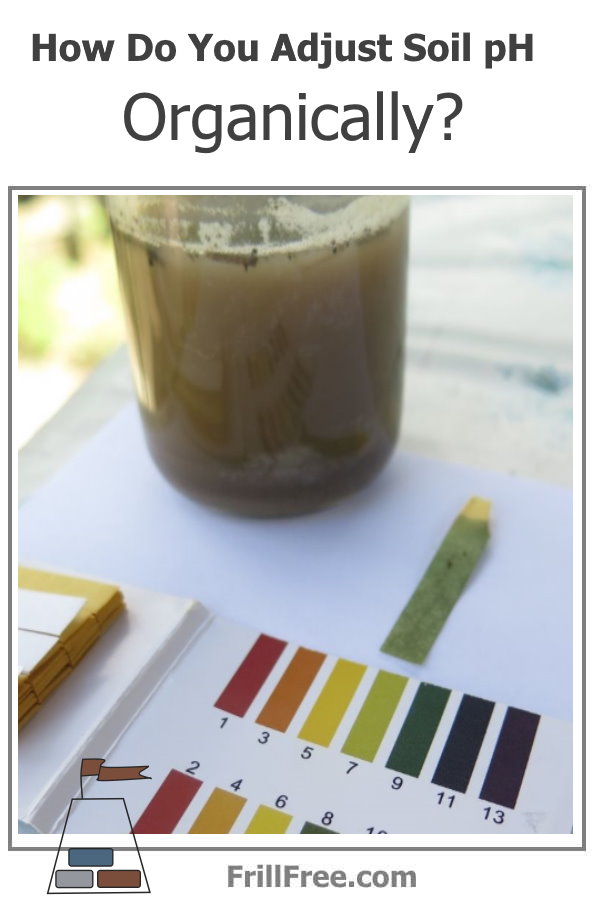- Homesteading
- Soil Fertility
- How Do You Adjust Soil pH Organically?
How Do You Adjust Soil pH Organically
Based on the Needs of the Plants? - 3 Easy Ways To Do It
Whether you’re trying to grow produce in a greenhouse or you simply want to get more out of the garden you already have, knowing how to adjust soil pH is the secret to organic gardening success and healthy chemical-free plants.
The
pH is a scale used to measure the acidity or alkalinity of the soil. As
we all know, the soil is the medium in which most plants live and grow,
and the quality of the soil affects plant growth. So, the knowledge of
adjusting the pH stability of the soil is a crucial part of the growing
process and makes you a better gardener.
As an example, the soil in the United States is in the range of 5 to 9 depending on the amount of rainfall. The 7.0 point is considered a neutral acidity. In other words, aiming for this level of acidity is what really matters, going lower or higher in some cases is also acceptable for some crops.
There are several ways to correct the pH of the soil in your garden, including mixing an organic soil conditioner with an organic homemade fertilizer, adding compost, or even planting acid-loving plants like blueberry shrubs.
If you have an organic garden or just want to grow a more nutritious and tastier vegetable, then check out these 3 easy natural methods for adjusting your soil's pH to help improve your garden's health and yield.
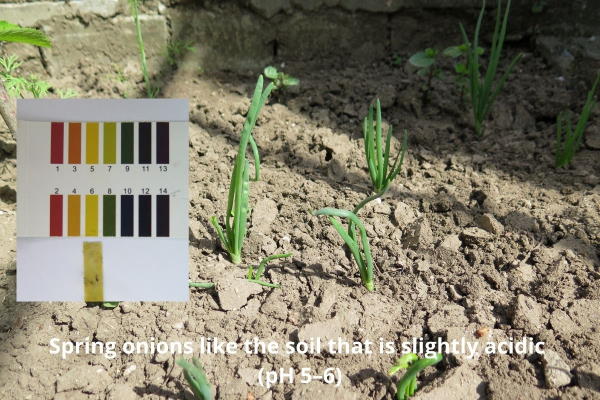 Spring onions like the pH to be on the acidic side, pH 5-6
Spring onions like the pH to be on the acidic side, pH 5-6Understand the Importance of Soil pH Adjusting
There’s a lot of talk about soil pH, but it's an incredibly important concept for farmers that don't get nearly enough attention. Every living thing on Earth requires a certain range of pH to thrive, including plants, animals, and humans.
Some plants grow better when the soil is acidic, while others need to have a slightly alkaline environment. If the pH gets too low, the plant will wither. Too high and it may die.
So, soil pH, along with soil structure and water supply, affects the growth of plants and the overall health of the soil. If the soil is too acidic, then soil organisms, such as earthworms, will die.
Plants that grow in acidified soil will require more nutrients to produce the same amount of food because there’s not as much available nitrogen in the soil. If the soil is too alkaline, however, then nutrients that should be available for plant growth will become unavailable. In general, an ideal soil pH range is between 6.0 and 7.5.
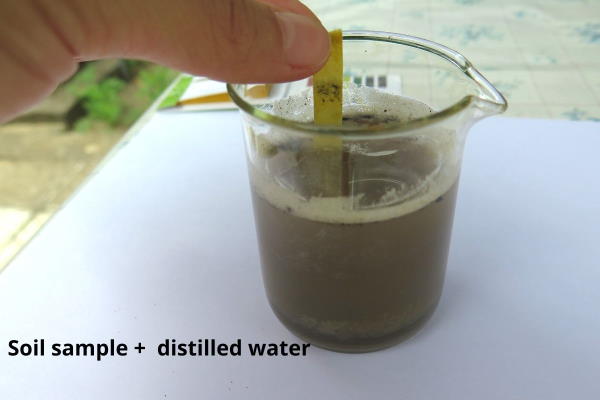 Testing the soil with pH strips
Testing the soil with pH stripsManage and Maintain pH levels
It is very difficult to maintain a constant pH level, which is why it is always necessary to monitor and control soil pH levels to ensure that there are no major fluctuations.
A pH meter will help to manage this. One way to check pH levels is to grab a pH test kit from your local garden store or pH test strips. These kits are inexpensive, but they will only give you an approximate value of the pH in the soil.
There are more sophisticated ways to measure the pH level of the soil using soil samples. A gardener can take a sample of soil from a small section of their garden, send the sample off to a laboratory, and get the results back in a couple of days.
Some methods for adjusting the pH levels are done with the help of chemicals. If you want an organic garden, then the next 3 methods will surely help you to maintain the garden as "organic" as possible.
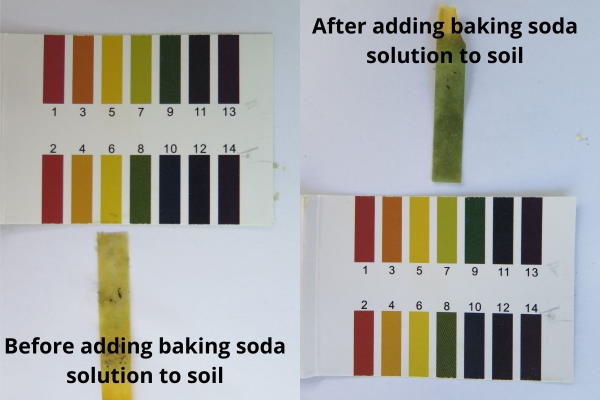 The pH is changed dramatically with the addition of baking soda
The pH is changed dramatically with the addition of baking sodaMethod 1 - Using coffee grounds as a way of adjusting the pH value
For those of us who don’t garden, coffee grounds are a great thing to throw into our gardens in the spring or fall. The reason is simple—coffee grounds contain acidifying elements that will help lower the pH of soil and water around your plants.
If you’re looking for a low-cost way to improve the health of your plants and the environment, coffee grounds are a great place to start.
You can easily just mix the coffee grounds with an organic mulch and then to the soil, depending on how long the coffee stayed grounded, the effect can vary. However, the average lowering of the acidity is around 0.5. After adding the coffee grounds into the soil, water the soil and get a pH test kit to see the results. But you have to take into account that the coffee grounds will only change the pH locally and it will not be permanent.
Method 2 - Organic mulch as pH balancer of the soil
There are many organic mulch materials available, but if you want to create an organic mulch, you must make sure that it’s the right material. Some of the organic mulches are peat moss, organic cotton, pine needle, pine bark, straw, and coconut shells.
All these materials make the soil more acidic after its decomposition, so you have to monitor the pH over time.
Method 3 – Using baking soda and vinegar water mix
If you want to reduce the pH or make the soil more acidic, you should use vinegar. To achieve that, mix 1 gallon of water and 1/8 - 1/4 cup of vinegar in the soil you're modifying, and pour the solution around the base of the plants. After some days, check the soil pH, if you need, dilute more vinegar in water.
On the other hand, if you need to raise the pH or make the soil more alkaline, add baking soda to the soil. The ratio of the mixture should be: 1 tablespoon of baking soda to 1-gallon of water then stir it. Apply the solution to your soil and observe the benefits right away.
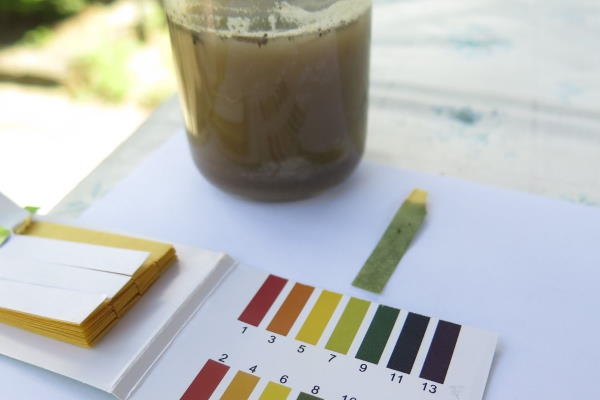 The soil is dissolved in the water, then tested to see what the pH is
The soil is dissolved in the water, then tested to see what the pH isFinal Thoughts on "How Do You Adjust Soil pH Organically Based on the Needs of the Plants
In conclusion, to have a successful gardening experience you must know the pH level in your soil and what kind of soil the type of plants you grow needs. If you are not satisfied with the pH levels of your soil, you can use the methods we mentioned in order to adjust the levels of pH. In other words, get a pH level test and learn about the needs of your garden, then apply what's needed.
Thank you for reading our look on "how do you adjust soil pH organically based on the needs of the plants".
Author’s Bio
Tony Manhart is the founder and editor-in-chief at deepnaturegardens.com. Tony’s enthusiasm and rich experience in all things related to growing plants have led him to share his knowledge with gardening aficionados all over the world. When he is not working around his garden, Tony spends his time writing tips and tricks on various subjects related to plant cultivation and soil maintenance.
